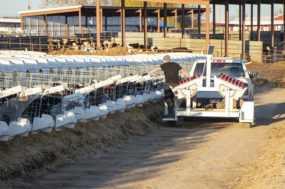A smaller milking herd, tight replacement heifer supplies to keep barns full and slight improvements in milk income margins continue to contribute to a slowdown in dairy cull cow marketing.
Based on latest USDA monthly data released April 25, the number of dairy cull cows marketed through U.S. slaughter plants in March 2024 was estimated at 244,600. While down 8,100 from February and the highest monthly total since August, it was 61,600 fewer than March 2023 and the lowest March total since 2009.
Through April 13, USDA Ag Marketing Service estimates indicate the number of dairy cows marketed for beef has now trailed year-ago levels for 32 consecutive weeks, dating back to Sept. 9, 2023, and was down 215,600 from the same period a year earlier.
March 2023 had 27 non-holiday weekdays and Saturdays, while March 2024 had 26 days. Slaughter averaged 11,800 head per business day this year, down about 800 from a year earlier.
The USDA estimated there were 9.335 million dairy cows in U.S. herds in March 2024, down 7,000 from the revised February estimate and putting the March culling rate at about 2.6% of the herd. Based on the monthly data, year-to-date (January-March) dairy cull cow slaughter now stands at about 747,500 head, down 123,000 from the same period a year ago and the lowest three-month total to start the year since 2010.
Read: Milk production declines in March USDA estimates
Heaviest dairy cow culling during March occurred in the Southwest (Arizona, California, Hawaii and Nevada) at 58,800 head. That was followed in the Upper Midwest (Illinois, Indiana, Michigan, Minnesota, Ohio and Wisconsin) at 56,300 head.
Other monthly regional totals were estimated at 33,800 head in Arkansas, Louisiana, New Mexico, Oklahoma and Texas; 32,300 head in Delaware, Maryland, Pennsylvania, West Virginia and Virginia; and 32,100 head in Alaska, Idaho, Oregon and Washington.
Primary data for the USDA’s Livestock Slaughter report is obtained from reports from about 900 federally inspected plants and nearly 1,900 state-inspected or custom-exempt slaughter plants.







